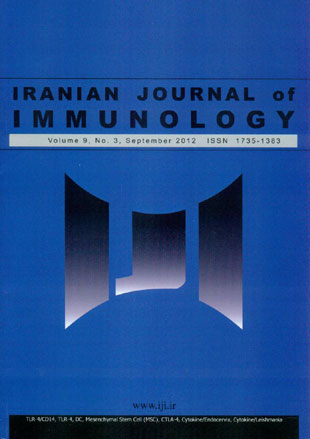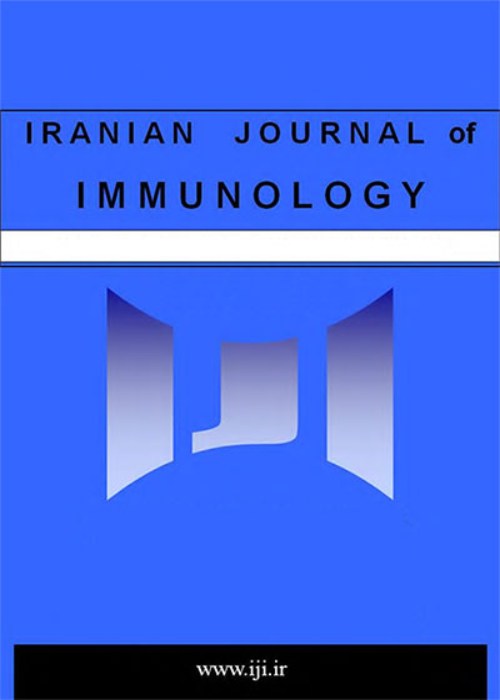فهرست مطالب

Iranian journal of immunology
Volume:9 Issue: 3, Summer 2012
- تاریخ انتشار: 1391/09/17
- تعداد عناوین: 7
-
-
Page 149BackgroundToll like receptors (TLRs) are well recognized players in inflammatory conditions. Among them TLR-4 is involved in chronic inflammatory processes such as formation of atherosclerotic plaques.ObjectiveThe present study was aimed to examine the effects of percutanoeus coronary intervention (PCI) as a revascularization method on monocyte expression of hTLR-4 and on the serum levels of two proinflammatory cytokines (TNF-α and IL-1β).MethodsBlood samples were obtained from 41 patients with stable angina who were andidates for PCI. The samples were collected immediately before and 2h and 4h after PCI. The expression of TLR-4 on CD14+ monocytes and the serum levels of TNF-α and IL-1β were measured usingflowcytometry and ELISA techniques، respectively.ResultsBy comparing the frequency of circulating hTLR-4+/CD14+ monocytes at different time points، it was observed that PCI procedure up regulates the monocyte expression of hTLR-4 (p<0. 05). The increase in expression was associated with the elevation of the serum levels of proinflammatory cytokines (p<005). There was a significant correlation between monocyte expression of hTLR-4 and serum levels of TNF-α and IL-1β only before PCI. In spite of parallel increase in the serum levels of proinflammatory cytokines and the monocyte expression of hTLR-4، the correlation did not attain a significant level after PCI intervals.ConclusionPCI is positively associated with an increase in the monocyte expression of hTLR-4. It is also associated with the elevation in the serum levels of proinflmmatory cytokines. These findings suggest that hTLR-4 monocyte expression may be used as a potential prognostic tool in patients with stable angina undergoing PCI.Keywords: Inflammation, Percutanoeus Coronary Intervention, Stable Angina, Toll Like Receptor, 4
-
Page 159BackgroundThe pathogenesis of migraine involves immune-mediated mechanisms in the vascular endothelium. Toll like receptor 4 (TLR-4) is a signaling receptor of innate immunity which plays a role in various neuropathologies related to neuron inflammation.ObjectiveThis case/control study is aimed to investigate whether TLR-4 896A/G variation is related to migraine headaches in an Iranian population.MethodsA total of 170 migraine patients (130 females، mean age 33. 24 ± 11 years) and 170 age، sex، and ethnicity matched healthy controls (118 females، mean age of 31± 10 years) were recruited. Genotyping was carried out using the tetra primeramplification refractory mutation system (ARMS) -PCR.ResultsThe frequency of G allele was higher in migraine patients than the controls (15% vs. 4. 7%; p<0. 0001). Interestingly، the distribution of heterozygous 896A/G genotype statistically differed between migraineurs and controls (25. 3% vs. 8. 2%، p=0. 00002، OR 3. 87، 95% CI; 2. 02-7. 4). Multivariate logistic regression analysis indicated that G allele in affected female migraineurs is an independent factor associated with increased risk of migraine (OR 3. 2، 95% CI 1. 23-8. 24، p=0. 01).ConclusionOur results showed TLR-4 polymorphism as a genetic risk factor for migraine. However، further studies in different populations are required to elucidate the precise role of TLR-4 896A/G mutation in susceptibility to migraine.Keywords: Female, Genetic Polymorphism, Inflammation, Migraine, Toll like Receptor
-
Page 168BackgroundT helper 1 and T helper 17 cells play important roles in immunity against foreign invaders. Differentiation of these Th subsets is affected by state of maturation and cytokines that are produced by dendritic cells (DCs). Curdlan is a linear (1→3) -β-glucan and has shown activity against tumors and infectious agents.ObjectiveThis study aims to investigate whether curdlan plays its role through affecting the maturation and cytokine production by DCs.MethodsDCs were isolated from the spleen of BALB/c mice by MACS method. After an overnight culture of DCs in the presence of curdlan، the expression levels of CD40، CD86، and MHC-II molecules were determinedby flow cytometry. The production of cytokines involved in Th1 and Th17 celldifferentiation (IL-12 and IL-6، respectively) was also evaluated by ELISA. Lipopolysaccharide (LPS) treated and untreated cells were considered as positive and negative controls، respectively.ResultsThe results of this study did not show a significant difference in the levels of surface expression of CD40 (p=0. 82)، CD86 (p=0. 79)، and MHC class II (p=0. 84) molecules upon exposure to curdlan. However،LPS increased the intensity of CD40 expression on dendritic cells (p=0. 04). In addition،it was revealed that curdlan-exposed DCs are not able to produce a significant amount of IL-6 and IL-12 cytokines. Conversely، LPS-treated DCs were able to make a significant amount of IL-12 (p=0. 005).ConclusionThe results of the present study suggest that curdlan has no effect on Th1 or Th17 differentiation while LPS may induce Th1 deviation by induction of CD40 expression and IL-12 production.Keywords: Dendritic Cells, IL, 12, IL, 6, CD40, CD86
-
Page 175BackgroundThe role of mesenchymal stem cell in cellular therapy is the subject of interest for many researchers. The differentiation potential of MSCs and abilities in modulations of the recipient’s immune system makes them important cells in tissue regenerative studies. MSCs by releasing the proinflammatory cytokines play important role in immunomodulatory systems; however the signaling pathways for releasing of these mediators are not well understood. Glutathione has been shown to play a role in modulation of cytokines in hepatogenic differentiation.ObjectiveIn the current study we aimed to investigate the effects of buthionine sulfoximine (BSO, inhibitor for glutathione synthesis) and N-acetylecystin (NAC, an inhibitor for ROS generation) on proinflammatory cytokines production in a hepatogenic differentiation model.ResultsBSO and NAC significantly decreased IL-6 and TNF-α levels at 14 days of ifferentiation, whereas, NAC decreased the levels of IL-8 at days 2 and 14 of differentiation. Moreover, intracellular glutathione level during the differentiation was depleted.ConclusionOur current study suggests a novel role of GSH as an immunopharmacological regulatory molecule during hepatogenic differentiation.Finally, this information may shed some light on the understanding of MSCs responses in transplantation and cell therapy in diseases such as chronic hepatic diseases.Keywords: Differentiation, Glutathione, Modification, Interleukins, Stem Cells, Tumor Necrosis Factor
-
Page 188BackgroundVariations in Cytotoxic T Lymphocyte Antigen-4 (CTLA-4) affect the expression and function of this protein.ObjectiveWe aimed to investigate the association of +49 A/G (rs231775), +1822 C/T (rs231779) and +6230 A/G (CT60, rs3087243) genetic variations, as well as the merged haplotypes in CTLA-4 gene with susceptibility to, or progression of head and neck cancer.MethodsEighty patients with confirmed head and neck (HN) cancer (age 54.9 ± 16.1 years) and 85 healthy age/sexmatched controls (age 56.3 ± 12.4 years) were enrolled in the study. Genotypes were investigated by the PCR-RFLP method. Arlequin software package was used to check for Hardy-Weinberg equilibration, and to estimate the haplotypes.ResultsAt position +6230 A/G (CT60), AA genotype, as well as A allele was significantly decreased in patients with HN cancers than controls (18.8% vs. 40.7%, p=0.004; odds ratio=0.34,and 46.3% vs. 61.7, p=0.007; odds ratio=0.53%, respectively). Nearly the same results were obtained when we compared the subgroup of patients with squamous cell carcinoma of the HN (SCC-HN) with control subjects. The frequencies of genotypes and alleles at other positions were not significantly different between patients and controls, however ACG, GTA and GCA haplotypes emerged from three investigated loci occurred with significantly more frequencies in patients (p<0.0001), while ACAand GTG haplotypes were more frequent among controls (p<0.0001). Significant differences of haplotypes, genotypes and alleles frequencies resisted the Bonferroni correction.ConclusionOur results suggest that CT60 A allele, as well as ACA and GTG haplotypes in CTLA-4 gene may have protective roles against HN cancer in Iranian population, while ACG, GTA and specially GCA haplotypes may rendersusceptibility.Keywords: Genetic Marker, CTLA, 4, Haplotype, Head, Neck Cancer, Polymorphism, Squamous Cell Carcinoma
-
Page 199BackgroundThere are strong evidences suggesting the secretion of different cytokines in cervical fluid during preterm labor. Betamethasone is widely administered for several reasons in preterm conditions.ObjectiveTo Investigate the possible effect of betamethasone on endocervical cytokine concentration of women at risk of preterm labor.MethodsIn a randomized clinical trial of 80 prime-gravid women in preterm labor between 34 and 37 weeks of gestation, cervical fluid was collected. Endocervicalconcentration of inflammatory cytokines were analyzed before and 48 hours after betamethasone treatment for the evaluation of IL-8, IL-17, IFN-γ and TGF-β. Wilcoxon and Mann-Whitney tests were employed for statistical analysis. χ2 and Student’s t tests were used whenever needed.ResultsAll the measured cytokines showed significant changes in the betamethasone treated group. IL-17 (p=0. 001), IL-8 (p=0.001), and IFN-γ (p<0.05) decreased significantly, while TGF-β had a significant increase (p<0.05). In the patients who delivered before or on the 7th day of admission, IL-17, IL-8, and IFN-γ levels were all significantly higher. However, TGF-β decreased significantly in the same samples in the betamethasone treated group (p<0.05).ConclusionBetamethasone significantly decreases the endocervical pro-inflammatory cytokine concentrations in patients with preterm labor.Keywords: Cytokine, IL, 8, IL, 17, IFN, γ Preterm Delivery, TGF, β
-
Page 208BackgroundLeishmania is a significant health problem in many parts of the world.Tumor necrosis factor (TNF) plays an essential role in Leishmania major infections.ObjectiveTo study the pro-inflammatory cytokines and antioxidants in four groups of cutaneous leishmaniasis patients.Methods39 patients were divided into four groups of: 1) active (acute phase of treatment); 2) non-healing (received treatment for almost two years without recovery); 3) healing (recovered upon treatment); and 4) healed (previously received treatment and achieved complete remission) patients. Serum levels of pro-inflammatory cytokines (IL-1B, TNF-α, IL-6) and serum antioxidant levels weremeasured by ELISA and FRAP assays, respectively.ResultsWhile serum antioxidant levels were elevated in the non-healing group, there was no difference among other groups of patients and healthy controls in this regard. Interleukin-1β showed the highest level in the non-healing group followed by the other groups of patients. The mean serum IL-6 level was highest in the non-healing group, but showed no significant change in the other groups. TNF-α and IL-1β levels were non-significantly elevated in the sera of active and non-healing patients.ConclusionPro-inflammatory cytokines IL-1β, TNF-α, IL-6 maybe related to the progression of leishmaniasis. Serum antioxidant levels maybe correlated with patient response to drug treatment.Keywords: Antioxidants, Cutaneous Leishmaniasis, Proinflamatory Cytokines


